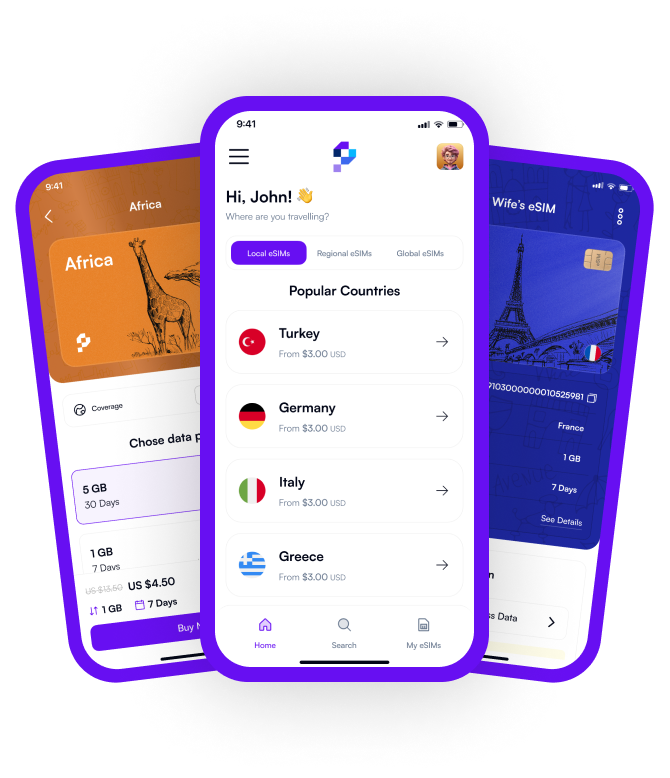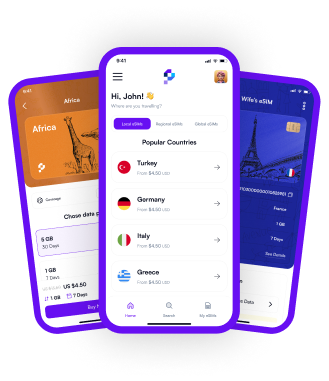Getting an eSIM in Europe typically involves a straightforward process, but it's important to note that availability and procedures might vary slightly between countries and mobile carriers. First, ensure that your device supports eSIM functionality, as not all devices do. Many newer smartphones and smartwatches offer eSIM support, but it's always a good idea to double-check with your device manufacturer or carrier. Once confirmed, acquiring an eSIM in Europe usually involves contacting your chosen mobile carrier either online, through their mobile app, or by visiting one of their physical stores. Some carriers offer the option to download the eSIM profile directly to your device, while others may require you to scan a QR code provided by the carrier. After completing the setup process, you'll be able to enjoy the benefits of having a digital SIM card, such as the flexibility to switch between different mobile plans and carriers without needing a physical SIM card swap.
It's worth noting that while eSIM adoption is growing in Europe, not all carriers may offer eSIM services yet, so it's essential to research which carriers in your region provide this option. Additionally, ensure that your device is unlocked or compatible with the carrier you intend to use, as this can affect the activation process. Finally, be aware of any potential charges associated with obtaining and activating an eSIM, as carriers may have different pricing structures for digital SIM cards compared to traditional physical SIM cards. By following these steps and staying informed about eSIM availability and compatibility, you can easily obtain and activate an eSIM in Europe to enjoy the convenience and flexibility it offers for your mobile connectivity needs.
Can I Get eSIM in Europe?
Yes, you can get eSIMs in Europe, as many mobile carriers across the continent have adopted this technology to offer more convenience to their customers. The availability of eSIMs may vary depending on the country and the specific carrier you're interested in. Generally, major mobile operators in Europe, such as Vodafone, Telefónica (O2), Deutsche Telekom, Orange, and others, provide eSIM services for compatible devices. These eSIMs function similarly to traditional physical SIM cards but are embedded in the device's hardware and can be activated remotely by downloading a digital profile.
To obtain an eSIM in Europe, first, ensure that your device supports eSIM functionality. Most newer smartphones, tablets, and smartwatches are equipped with this feature, but it's always wise to verify compatibility with your device manufacturer or carrier. Once confirmed, you can typically acquire an eSIM by contacting your chosen mobile carrier through their website, mobile app, or visiting one of their stores. The activation process usually involves downloading the eSIM profile directly to your device or scanning a QR code provided by the carrier. With an eSIM, you can enjoy the flexibility of managing multiple mobile plans or switching carriers without the need to physically swap SIM cards, making it a convenient option for travelers and those seeking greater flexibility in their mobile connectivity.
How Do I Setup eSIM in Europe?
Setting up an eSIM in Europe is generally a straightforward process, provided that your device supports eSIM functionality and you have chosen a mobile carrier that offers eSIM services. First, ensure that your device is compatible with eSIMs, which is common in most newer smartphones, smartwatches, and some tablets. Once confirmed, you can initiate the setup process by contacting your chosen mobile carrier through their website, mobile app, or by visiting one of their physical stores. The carrier will provide you with the necessary instructions and may either send you a QR code or prompt you to download the eSIM profile directly to your device.
To activate the eSIM, follow the instructions provided by your carrier. This typically involves scanning the QR code they provide or entering the activation code manually. Once the eSIM profile is downloaded and activated on your device, you can start using it immediately for calls, texts, and data services. With an eSIM, you have the flexibility to manage multiple mobile plans or switch between carriers without the hassle of physically swapping SIM cards. This convenience makes eSIMs an excellent option for travelers and individuals seeking more control over their mobile connectivity in Europe.
Why Should You Use ESIM in Europe?
Using eSIM in Europe offers several compelling advantages for both residents and travelers. Firstly, eSIM technology provides greater flexibility and convenience compared to traditional physical SIM cards. With an eSIM, you can easily switch between different mobile plans and carriers without needing to physically swap SIM cards. This flexibility is particularly beneficial for travelers visiting multiple European countries, as they can seamlessly switch to local mobile plans without the need for a new physical SIM card in each destination. Additionally, eSIMs are ideal for individuals who frequently switch between personal and work phone numbers, as they can manage both profiles on a single device.
Moreover, eSIMs contribute to reducing environmental waste by eliminating the need for physical SIM cards, which often end up discarded or replaced. By using eSIM technology, individuals can contribute to sustainability efforts by reducing the production and disposal of plastic SIM cards. Furthermore, eSIMs offer enhanced security features, such as remote SIM provisioning and the ability to lock or erase the eSIM profile remotely in case of loss or theft. Overall, the convenience, flexibility, and environmental benefits make eSIMs a compelling choice for mobile connectivity in Europe.
How Much is eSIM in Europe?
The cost of eSIM in Europe can vary depending on the mobile carrier and the specific plan you choose. In many cases, the price of an eSIM plan may be similar to traditional physical SIM card plans offered by the same carrier. Some carriers may even offer eSIM plans at a slightly discounted rate or with special promotional offers to encourage adoption of this technology. Additionally, since eSIMs eliminate the need for physical SIM cards, there may be savings associated with not having to purchase or replace traditional SIM cards over time.
It's important to note that while the initial setup and activation of an eSIM profile may not incur any additional charges, there could be fees associated with data usage, calls, and text messages depending on the terms of your chosen eSIM plan. Before selecting an eSIM plan in Europe, it's advisable to carefully review the pricing details and terms of service provided by the carrier to ensure that it meets your needs and budget. Additionally, be aware of any roaming charges that may apply if you plan to use your eSIM while traveling outside your home country within Europe.
Does Android Support eSIM in Europe?
Yes, Android devices do support eSIM functionality in Europe, as well as in many other regions around the world. Many newer Android smartphones and tablets come equipped with eSIM support, allowing users to activate digital SIM profiles provided by their mobile carriers. This feature offers users the flexibility to easily switch between different mobile plans and carriers without the need for a physical SIM card swap. Additionally, Android device manufacturers continue to expand support for eSIM technology, ensuring compatibility with a wide range of devices across various price points.
To use eSIM on an Android device in Europe, users typically need to ensure that their device supports eSIM functionality and that their chosen mobile carrier offers eSIM services. Once confirmed, the setup process usually involves contacting the carrier to obtain the eSIM profile, either through their website, mobile app, or physical store. Android's intuitive interface makes it easy for users to download and activate the eSIM profile, enabling them to enjoy the benefits of digital connectivity in Europe with greater convenience and flexibility.
Can I use both eSIM and physical SIM in Europe?
Yes, in many cases, you can use both eSIM and a physical SIM card simultaneously in Europe, provided that your device supports dual SIM functionality. Many modern smartphones, including those running on Android and iOS operating systems, offer dual SIM capability, allowing users to use both eSIM and physical SIM cards concurrently. This feature is particularly beneficial for individuals who need to maintain separate personal and work phone numbers or who frequently travel between different countries and wish to use local SIM cards alongside their primary eSIM plan.
To use both eSIM and physical SIM cards in Europe, you'll need to ensure that your device supports dual SIM functionality and that your mobile carrier offers eSIM services. Once confirmed, you can typically activate the eSIM profile and insert the physical SIM card into your device. Depending on your device's settings, you may be able to designate which SIM card is used for calls, texts, and data, or you may have the option to switch between the two SIM cards manually. This flexibility allows users to enjoy the benefits of both eSIM and physical SIM cards, such as cost savings, network coverage, and convenience, simultaneously in Europe and beyond.

